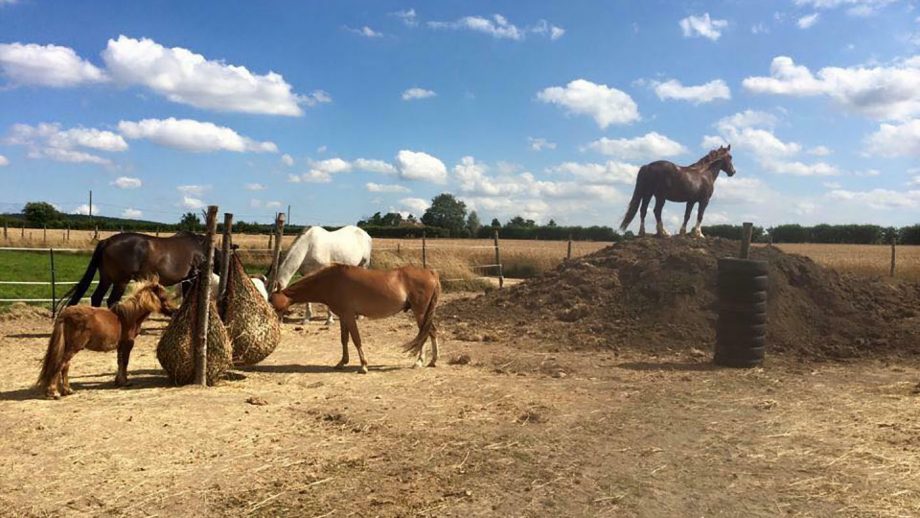H&H canvasses opinions from vets and farriers, who are warning horse owners to be on guard for laminitis and calling for them to be honest with themselves about their horses’ weight so action can be taken if weight loss is needed...
Owners are being reminded about the importance of being vigilant about laminitis all year round — and not focusing on it as a “seasonal” disease.
Professionals are urging owners to act now to reduce horses’ and ponies’ weight, and to seek immediate veterinary advice if they see signs of the condition.
Chloe Casalis de Pury, of Buckinghamshire-based Chess Valley Equine Vets, has treated two acute cases of laminitis this year involving ponies who had no history of the disease — and were being kept on “bare” paddocks.
“We’re seeing more laminitis in what we traditionally used to think as ‘safe’ periods, whether that’s late autumn or very early spring. Both ponies are mild cases, but we are hearing anecdotally of others who are becoming ‘footy’ too,” she told H&H.“We are becoming more aware of laminitis and less tolerant of the chronically footy pony, which means we’re seeing these acute or chronic flare-ups more than we would have done 10 years ago.”
Dr Casalis de Pury said it is never too late for owners to act.
“Now is the time to be taking precautions, such as restricting grazing or using track systems that encourage movement, especially if horses or ponies are still carrying too many pounds. There are very few excuses — to say ‘My horse will be OK’ is not appropriate,” she said.
“It is one of the worst diseases a horse could face. We have seen international dressage horses put down because of this disease.”
Lucy Grieve, member of the British Equine Veterinary Association’s (BEVA) ethics and welfare committee, told H&H it is important not to focus solely on “seasonal” laminitis.
“Grass growth, and therefore sugar levels, can vary from day to day, never mind between the seasons, so it’s not as simple as we would hope. There is the common misconception if the field is ‘bare’, it’s safe — but the grass is simply being eaten as quickly as it is growing, therefore the horse is still consuming potentially dangerous amounts,” she said.
“Obesity is the biggest cause of pasture-associated laminitis, so it stands to reason that keeping horses slim will reduce risks. I urge owners to be honest about weight; we can instinctively know our horse may be more fat than fit, but sometimes it feels easier to bury our head in the sand.”
Farrier Antony Marris told H&H laminitis can be fatal in horses and ponies of all breeds and sizes, adding that unpredictable weather can catch owners out.
“In the past couple of years, we’ve been getting some really extreme weathers so it can be difficult to manage if we’ve had mild weather, then a sudden hard frost or influx of snow — these can be serious triggers,” he said.
“If an owner does suspect laminitis, they shouldn’t hesitate to seek advice — it’s a veterinary emergency.”
Keep horses moving
A good way to help manage horses’ and ponies’ weight and reduce the risk of laminitis is movement.
Ms Grieve and Dr Casalis de Pury agreed that implementing an exercise programme and creating a track system can be useful.
“Don’t let your horse sit in the field like a couch potato,” said Ms Grieve. “Do more with them — they are athletic animals who enjoy exercise and the more they do, the fitter they’ll get and the more you will both benefit. If you really want to enhance their daily life, invest in a track system and research ways to enrich their environments — they’ll thank you for it!”
Dr Casalis de Pury said a track system restricts grazing while encouraging a horse to move.
“Instead of strip grazing, you run an electric fence around the outside of the field so you are minimising the acreage the horse can graze,” she said.
“If water is at one end, the gate at the other and any supplementary hay in the middle, you encourage them to walk around more than if they’re standing on a postage stamp of grass and are incredibly bored — that’s not great for welfare either.”
“I’ve seen people use different surfaces, such as a loafing area with woodchip or sand where horses can enjoy a roll — you can get as imaginative as you want,” she said.
You may also be interested in…

Track living: the alternative horsey set-up

Laminitis: how to spot the signs, plus treatments and ways to prevent it

Owners struggling to spot overweight horses
A survey has found that owners could be struggling to see when a horse is overweight

Owner’s weight warning after obese mare came within ‘hours of death’
The owner is urging others to take action on overweight horses

Why attitudes to overweight horses must change to save lives *H&H Plus*

